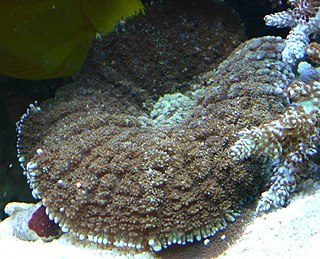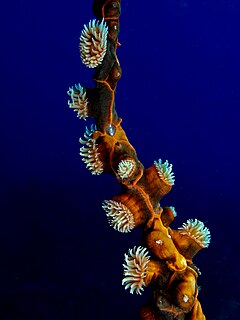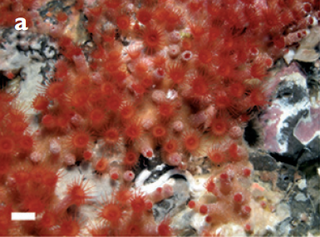
Tube-dwelling anemones or ceriantharians look very similar to sea anemones but belong to an entirely different subclass of anthozoans. They are solitary, living buried in soft sediments. Tube anemones live inside and can withdraw into tubes, which are composed of a fibrous material made from secreted mucus and threads of nematocyst-like organelles known as ptychocysts. Within the tubes of these ceriantharians, more than one polyp is present, which is an exceptional trait because species that create tube systems usually contain only one polyp per tube. Ceriantharians were formerly classified in the taxon Ceriantipatharia along with the black corals but have since been moved to their own subclass, Ceriantharia.

Edwardsia is a genus of sea anemones, the type of the family Edwardsiidae. They have eight mesenteries and live in tubes in the sand. The name, in New Latin, commemorates the French zoologist Henri Milne-Edwards.

Rhodactis is genus of Mushroom corals which are characterized by large individual polyps that are often reminiscent of a mushroom. Rhodactis are related to stony corals but do not produce a stony skeleton.

Alicia is a genus of sea anemones in the family Aliciidae and contains the following species:

Corynactis is a genus of colonial anthozoans similar in appearance to sea anemones and in body format to scleractinian stony corals. These animals are cnidarians in the family Corallimorphidae. Large unidentified polyps of this genus feed on the crown-of-thorns seastar Acanthaster planci and may help control the crown-of-thorns population.

Amphianthus is a genus of sea anemones. It is the only genus in the monotypic family Amphianthidae.

Hormathiidae is a family of sea anemones in the class Anthozoa.

Sagartiidae is a family of sea anemones.

Bunodosoma is a genus of sea anemones in the family Actiniidae.

Parazoanthus is a genus of anemone-like anthozoans in the order Zoantharia.

Sagartia is a genus of sea anemones in the family Sagartiidae. The genus was first described by Philip Henry Gosse in 1855 and the image is his painting of several species found in British waters included in his book, A history of the British sea-anemones and corals.

Zoanthus is a genus of anthozoans in the family Zoanthidae. It is the type genus for its family and order.

Anemonia is a genus of sea anemones belonging to the family Actiniidae.

Palythoa is a genus of anthozoans in the order Zoantharia.
James Edwin Duerden or J.E. Duerden M.Sc., Ph.D., A.R.C.S. was a British zoologist who became an international expert on the wool industry.

Pachycerianthus is a genus of marine tube-dwelling anemones in the family Cerianthidae.
Lithodesmium is a genus of diatoms belonging to the family Lithodesmiaceae.

Terrazoanthus is a genus of corals belonging to the family Hydrozoanthidae.
Gyrostoma is a genus of cnidarians belonging to the family Actiniidae.















